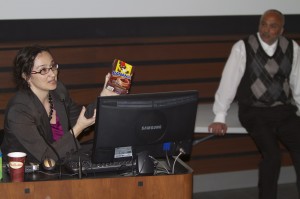
Who can label racism?
- Erica Lehrer donates a local object to David Pilgrim for the Jim Crow Museum after Dr. Pilgrim’s talk
On February 18, 2011 Dr. David Pilgrim, founder and curator of the Jim Crow Museum in Big Rapids, Michigan, led 15 Concordia students and faculty in the workshop “Contemptible Collectibles: Curating ‘Difficult’ Objects.” The workshop created a space in which to think about representations of race, and how objects with hateful, stereotypical depictions of ethnic groups might be employed as catalysts to dialogue.
We broke into small groups, each of which was given an object bearing images of African Americans. We were asked to brainstorm every word or phrase that came to mind, resisting the impulse to censor our thoughts. Our next task was to write a descriptive label that would relate the object’s essence to a museum audience, using no more than twenty-five words.
Both groups approached the writing with the same goal in mind: to encourage spectators to linger with the object and think deeply about what they see. But our descriptions turned out to be quite different, and out of that difference came the most fruitful discussion of the workshop. The first difference was the way our language reflected the positions of authority we adopted. While the first group limited what they were willing to state authoritatively to the provenance of the object (a t-shirt), describing it as “mass produced” and “Korean made,” the second group chose to write from a position of moral authority, stating that the image on their letter box was a “demeaning” and dehumanizing” representation. And while both groups posed a question to encourage visitor engagement, the first group asked “What do you see?” and the second asked: “How does this make you feel?”
The goal was not to devise one correct way of displaying objects that depict racist stereotypes. Instead we discussed and debated the challenges posed by our attempts to frame these objects for public audiences: which strategies might facilitate dialogue and reflection, and which could impede it? What the workshop effectively demonstrated was the need to include multiple perspectives when framing racist stereotypes. Each of us stands at a particular intersection of race, class, gender, nationality, age and education, and our perspectives are formed from these vantage points.
From only fifty words, many questions emerged: Who has the right to declare a depiction racist or speak about the effects of racism? How does one identify representations as problematic without dismissing feelings of nostalgia, empowerment, or creative re-appropriation – particularly when expressed by members of the group depicted? Where is critical distance appropriate, and when does it risk erasing – or activating – painful emotions? Ideally, exhibiting these objects would create a space for diverse perspectives on racial stereotyping to be better understood as both a past and present phenomenon, and where racism and its complex effects will begin to lessen their hold on us.
Post by Kim Moore & Erica Lehrer
Click here to watch a Concordia University TV report about Dr. Pilgrim’s visit.



